Works involving the performing arts—such as music, sound recordings, choreography, movies, and video games—all fall under the same general category in regards to registration with the U.S. Copyright Office.
This means that they are all equally protected under copyright law, and can be registered in generally the same ways using the Electronic Copyright Office portal.
Regardless of whether music is your passion or your profession, it's wise to take basic steps to ensure your work stays protected.
In most cases, this means registering your music with the Copyright Office under the performing arts category mentioned above.
In this article, we'll cover the seven basic steps you'll need to take when registering a copyright for your music.
Note, however, that we're only covering basic legal information. Always consult with an attorney if you have any specific questions about what you should do in your particular case.
Why Should I Register a Copyright for My Music?
Before we start, it's important to highlight the largest benefit of registering a copyright for your music.
In the United States, all creative works gain basic copyright protections from the moment they are fixed in a tangible medium of expression (such as a file on your computer or a CD on your desk).
This means formal registration is not a requirement for a work to be protected under current copyright law.
Instead, registration is a mechanism that allows copyright holders to enforce their rights in court, among other benefits.
Put another way, you can only file an infringement lawsuit if you hold a copyright for the infringed work in question.
While you can certainly register your work after the instance of infringement—usually up to around three months after you find out about the infringing work—it's still wise to take proactive steps to protect your content due to the other benefits that copyright registration provides (such as a public record of your ownership, a presumption of validity in litigation, and access to additional statutory damages and other awards).
7 Steps to Registering a Copyright for Your Music
Registering a copyright is relatively easy, provided you follow the instructions available on the U.S. Copyright Office's website.
In general, this process can be broken down into seven basic steps, as outlined below. However, please keep in mind that we're simply explaining the basics of this process.
Please consider speaking with an attorney if you have any specific questions about the copyright registration process.
1. Make Sure Your Work is Copyrightable
The first and most important step is to ensure your work is actually copyrightable.
As noted in Circular 1 on Copyright Basics, copyright is a form of legal protection provided by U.S. Law to the creators of "original works of authorship" that are fixed in a tangible form of expression.
This means you need to ensure that (1) your work is original and unique, and does not infringe on any existing copyrights, and (2) you need to fix your work in a tangible medium of expression, such as a CD, an audio file, or some other record of your specific work.
Further, you need to ensure your intended copyright doesn't fall outside the current bounds of U.S. copyright law, such as if you attempt to copyright a particular dance move in your song or if you want to register a copyright for a specific verse in your song (as opposed to the entire thing).
Notably, copyright law does not protect:
- Ideas, procedures, methods, systems, processes, concepts, principles, or discovers (which are normally protected under patent law);
- Words that are not fixed in a tangible form, such as improvised choreography or speech that is not fixed in a tangible medium such as audio or film;
- Titles, names, short phrases, slogans, symbols, or designs (which are normally protected under trademark law);
- Basic typographic variations of other works, such as if you adjust the ornamentation, lettering, or coloring of a work;
- Basic listings of ingredients, processes, or contents (such as in the case of general or basic recipes).
Put simply, there are several different types of intellectual property law (copyright, trademarks, patents, and trade secrets) and copyrights cannot protect content that falls under one of the other categories.
Creating an owl-themed music podcast called "The Hoo," for instance, may lead to copyright protections for the work as a whole (and any original owl-themed music you play on it).
However, you may also have to register your new podcasts's name as a trademark to gain protections for that particular phrase.
Music includes two important and separate elements that may be copyrightable, a musical composition and a sound recording. The composition includes the lyrics and musical notes (traditionally recorded on paper on a musical staff), and the sound recording includes the recording of your performance of the song (traditionally in a studio owned by a music label).
Depending on your circumstances, you may be able to register for both the composition and the sound recording (the master). If you have co-publishers or songwriters, or if you work under a record label, then you should verify what you are able to register and that your work is protected properly.
2. Navigate the U.S. Copyright Office's Website
Once you're ready to apply, you should head over to the Copyright Office’s page dedicated to copyrights for “the performing arts."
On this page you can find a lot of tutorials about filing for a copyright and filling out the paperwork, as well as several different previews of the application.
You should take time to review these resources at length (especially the video tutorials), as they contain a great deal of information that may be helpful to your application.
And when you’re ready to move on, click the button that says “Register a Work of the Performing Arts.”
3. Register or Log In
After you click "Register a Work of the Performing Arts," the site will redirect you to a login page that asks for your Copyright Office User ID and Password.
If you already have login information for this site you can just enter it into the required boxes and proceed to the next step.
If this is your first time using the system, you should click "New User" below the login prompts to create a new account.
4. Complete the Registration Application
Once you are logged in, click the “Register a New Claim” tab. This will bring you to the actual application. Fill the application out as accurately as possible, and feel free to refer to the video tutorials if you get confused.
5. Select the Best Edition of Your Work
When you submit your application you will need to attach a copy of your work. However, the copyright office only wants the “best edition” of your work.
In general, the best edition refers to the version of your work that is (1) the highest quality, and (2) the best suited for archival purposes.
For music, you will want to submit your final mixes as your best edition, rather than a rough cut, radio-edit, or some other non-final version.
If you are submitted a hard copy, like your song composition or CD, make sure it is stored in a high-quality manner.
6. Submit the Application and Pay the Required Fees
Once you finish your application, re-read your materials and make sure there are no mistakes. As we mentioned, it can cause significant delays if you incorrectly fill out the application.
Once you've verified everything, you can submit your application and proceed to the fees.
It will cost $45 if you are the only author and claimant filing online. Otherwise, it will be $65.
If you file an application for multiple musical compositions or sound recordings, then you may be eligible for group registration rates. Group registration allows you to file several separate claims at the same time for a discounted rate.
Keep in mind that we've largely been discussing the process for electronic filings. Paper submissions have a slightly different process and will cost $125.
7. Wait Out the Processing Times
Once you submit all your materials there's nothing left to do but wait. You can check processing times here, but keep in mind that these are only rough estimates.
In the meantime, keep your materials organized in case you need to correct your submission.
You can also get to work employing tips and tricks to maximize your copyright protections.
These include making proper use of the copyright symbol on your works, setting up avenues where other artists can contact you about using your work, joining a PRO, and meeting with a lawyer about licensing agreements.
Conclusion
Registering a copyright for your music may seem like a daunting task, but it's actually pretty simple in practice.
All you have to do is log into the U.S. Copyright Office's website and fill out a few forms. They even provide detailed video walkthroughs to help you through the process.
Note, however, that copyright registration does not equate to copyright enforcement. Instead, registration is simply a prerequisite for legal action against an infringing party.
If someone has infringed on your copyright, you should speak with an attorney immediately about your case.
Infringement cases often operate on tight deadlines, so it's critical that you seek out experienced help as soon as possible during the process.

